Dee Estuary Birding
Monthly Newsletter...
July 2022 Newsletter

Snowy Egrets, Pacific Swifts and
other tall stories
When I first started this website I was no more than
a casual
birdwatcher so it was both a privilege and an eye opener to get to know
the local birding community - many of which have since become good
friends. It was a steep learning curve for me, to say the least, and I
soon learnt that some birders you could trust their bird identification
skills with your life - and if they weren't sure about something you
could be sure they would say so. Others, like me, are happy to go along
with what the experts say! But then you get some who are, lets say,
over-enthusiastic seeing rare and scarce birds where there aren't any,
so another thing I learnt was to be sceptical when necessary, and
that's quite a skill to learn as people can get upset if you doubt them.
Over the 24 years of the life of deeestuary.co.uk I have been sent many
thousands of records the vast majority of which have been absolutely
reliable, a few where there have been obvious mistakes which, for the
most part, have been easy to spot but then just a handful have been
rather strange for one reason or another. It's some of these latter
ones which I thought would be amusing to share with you and probably
tells us more about human nature rather than birds. To save
embarrassment I have not named anyone, although I'm sure many locals
will recognise them, but I would say they all involve what most people
would regard as experienced birders.
Nightingales and Wood Warblers at Connah's Quay.
By 2004 my website was well established but it's
always been the case that I get fewer records from the Welsh side of
the estuary simply because there are fewer people birding there. So I
was pleased in April that year when I started getting reports from
Kelsterton Wood which is an area of woodland not far from Connah's Quay
Nature Reserve. I didn't know the birder in question but recognised the
name as someone involved with the Deeside Naturalists Trust.
I got two emails initially detailing totals of warblers heard - nothing
unusual, just counts of singing Blackcaps, Chiffchaffs etc. but very
welcome records. Then out of the blue I get "this morning I heard two
Nightingales and 10 Wood Warblers in Kelsterton Wood". This came
without any comment, you'd think singing Nightingales and multiple
records of Wood Warblers were commonplace in Flintshire - which they
most definitely are not! Also very strange was the fact such a
remarkable record wasn't reported anywhere else. Nightingales are not
completely unknown here on the west coast of the UK but they are very
rare with just the odd record of single birds, nearly always in May and
are single individuals who have over-shot their normal range. According
to 'The Birds of Wales - 2021' there were a total of just 16 records in
the whole of Wales between 2000 and 2019. A singing Wood Warbler, even
two, at Kelsterton would not be particularly unexpected but even so the
presence of just one or two of these scarce warblers would certainly
excite the interest of local birders - but having 10 all singing in one
small wood was totally unbelievable!
So what was going on here? What was the motive for sending me obviously
duff info? Was he testing me, knowing I was an inexperienced birder?
Did he have a chip on his shoulder about Welsh birds being reported on
an English website? Was he just a fantasist? I can't remember my
reaction at the time, but am pretty certain I just ignored it and I
never heard from that person again.
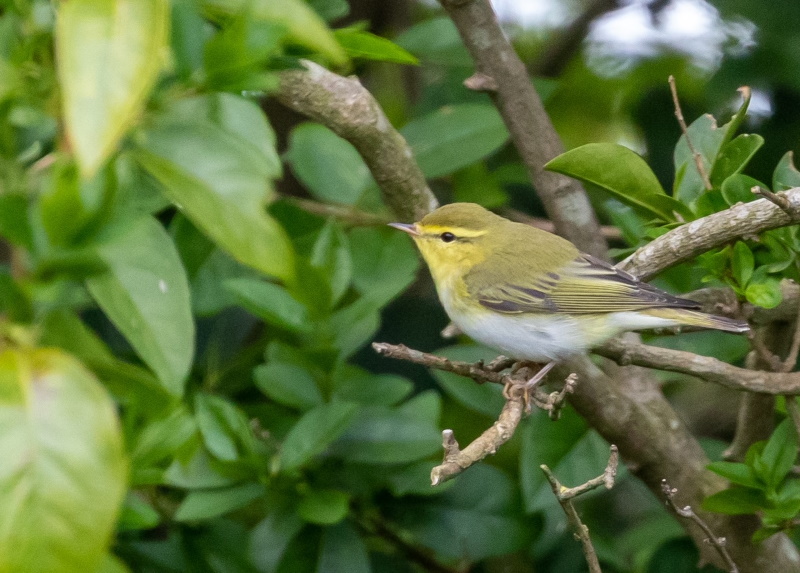
© Peter Sutton
An Iceland Gull and mass delusion at Meols.
You've probably heard of twitches, or even been to
one, where the first person to see the bird thinks it's species X. And
then everyone else arriving to see the rarity just goes along with the
original ID until some 'know all' turns up, perhaps a day or two later,
and says - 'it looks like species Y to me' - and everybody is left with
egg on their face! Well, something similar happened at Meols in April
2005.
I remember getting a text 'Iceland Gull at Meols' and I dashed down to
have a look as I'd never seen one. Although regular in some parts of
Cheshire they are less than annual on the Dee Estuary/North Wirral so
it was a good rarity to see here and when I arrived many local birders
were there including the north Wirral's regulars. With so many
experienced birders present it didn't even cross my mind to
question the identification, photographs were taken and everybody went
home happy. Then I got an email - 'examination of the photos suggest it
might not be an Iceland Gull and it's now thought to be a leucistic
Herring Gull'. It was quite a shock to find out that even the most
experienced birders get it wrong sometimes, but it also amused me
to find out these experts were human after all!!
A mega over West Kirby?
The sighting of a rare bird always causes excitement
but it is somewhat dampened if only one person gets to see it,
particularly so if that person has a bit of a reputation for reporting
birds nobody else gets to see. Such was the case for a Pacific Swift
over West Kirby in September 2007 which was greeted with incredulity
and even anger by some birders. Pacific Swifts are mega rarities and up
to 2007 only three had been accepted by BBRC, although it must be said
a lot more get reported than accepted (most are reported as 'probables'
as was the West Kirby bird) and the fact that there have been two
further 'probable' Pacific Swifts in our wider area since 2007 (one at
Southport and another at Hale) suggests that the West Kirby bird wasn't
quite as unlikely as it might seem (and it did appear after prolonged
easterly winds).
Being only ever a probable and with just one person seeing the bird it
was no surprise this record was rejected by the BBRC - but not before a
letter was sent by some irate birders to BBRC strongly suggesting the
record was unsafe, an unprecedented step! I have never known a birder
to polarise opinions so much. Those who knew him well, including
myself, were of the opinion that he was an experienced and reliable
birder, not only that he had recently co-led a birding tour to Japan
where Pacific Swifts are commonplace so knew the species well. He is a
birder who is out in the field nearly every day and usually alone - so
it was no surprise he was often the only one to see particular birds.
Other birders saw him as a 'stringer', and for those who don't know
here is the definition of a stringer - "a birder who repeatedly claims
dubious sightings. Dubious species or dubious counts, often flyovers,
or 'passing through' in some way, and characteristically NEVER seen or
witnessed by any other birder." What do I now think after 15 years
since the Pacific Swift was claimed? Well, I just don't know and think
it's best to leave it like that.
Egret Lores
News of rare birds rarely get into the local press
but this was in the Liverpool Echo in October 2008 "Mersey birdwatchers
are in a flap over what could be one of the rarest visitors to UK
shores in years. At the weekend, Wirralís twitching community exploded
with talk of a Snowy Egret sighting which, if confirmed, would make it
only the second time the American bird has been sighted in the UK.
Experts say the borough could have to brace itself for a flood of
hundreds of birders from across the country."
It was a bright sunny day at Meols on Oct 18th 2008 when a birder saw
an egret which immediately set alarm bells going as it appeared to be a
Snowy Egret, and if that was the case it would be only the second one
ever recorded in the UK. The bird seemed to have two identification
characteristics of a Snowy Egret - yellow lores and light coloured
legs. At the time this was the first I've heard of 'Lores' in relation
to birds but it is the bare skin between the eyes and the bill (see
photo below).
Unfortunately, despite much searching, the bird wasn't relocated and
also unfortunately the photos taken on the 18th were inconclusive as
the bird was somewhat distant. However, during the following two days a
Little Egret (probably a juvenile) was seen variously described as
having 'yellowish lores' and 'pale legs and lores'. The birder who saw
the original Egret seemed sure this Little Egret seen on the 19th and
20th was not the same bird he had spotted, but it has to be said that
the light conditions were very different being bright sun on the 18th
and dull and overcast on the 19th and 20th.
If it was a Snowy Egret it was never relocated either here or elsewhere
in the country - so definitely one that got away!
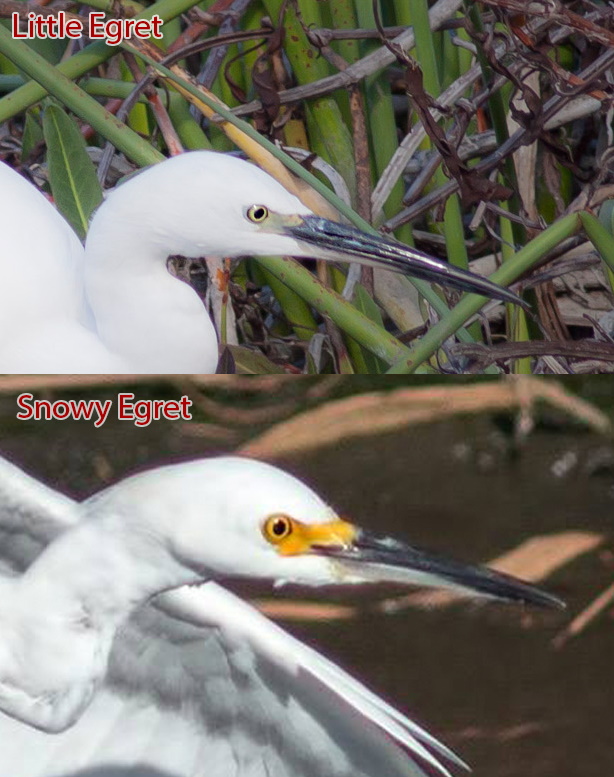
A mystery bird at Leasowe
It was a mild February day in 2011 when I got an
email with rather vague details of a bird the observer didn't recognise
which was in one of the paddocks at Leasowe Lighthouse; he'd seen it
that morning but it had disappeared. It appeared to be some kind of
wading bird so I replied giving him my mobile number asking him to ring
if he saw it again. An hour later my mobile rang, the bird had
reappeared.
He still didn't know what it was and I tried to make sense of his
description. I distinctly remember asking about the bill and the answer
was that it was heron like. So the conclusion was that we had a small
heron type bird which was mainly grey/brown in colour. I quick look in
my Collins Bird Guide and I realised there wasn't much to choose from
and I came to the conclusion that it was probably a Little Bittern and
that's what I put out - 'a probable Little Bittern'. Needless to say
there was no further sign of this bird when other birders, including
myself, turned up to look for it. Looking back at this now I'm
embarrassed by my conclusion. I'd made assumptions which weren't valid
not least that it was possible for a Little Bittern to be in north-west
England in February when, in fact, they spend the winter in Africa -
but in my defence there had been recently been some strong southerly
winds so just maybe! More understandably, perhaps, was that I assumed
the person who saw this bird was an experienced birder - although I
didn't know him well I did know he was a regular at Leasowe Lighthouse
so it was a reasonable assumption to make.
I remember getting irate with somebody who suggested that it was
probably just a Snipe, and I pointed out that it had been reported by a
birder and not just some non-birding dog walker which some had
concluded. It was only later, when a friend of mine said she had seen a
Black-tailed Godwit in that field that same morning, that I started
having doubts about this whole embarrassing episode. I'm sure you will
think that surely any birder knows what a Black-tailed Godwit looks
like, but they are rare along that part of north Wirral so it may well
be that a casual birder who only visits the Leasowe area was not
familiar with them. On the other hand may be it was something very rare
and we all dipped out on it!
Lesser Yellowlegs and an anonymous verifier
This involved a birder who always went out by
himself and seemed to see a lot of birds, including the occasional
rarity, which nobody else ever saw. But he had a strange attitude to
his fellow birders which basically was "I found this rare bird a couple
of days ago, but
I'm not going to tell you where it was, you'll have to find it for
yourselves". Every other birder I know is only too keen to share their
find, if only to confirm the identity and the more people that see it
the more likely it is that it will be accepted by the relevant rarity
committee.
The most notorious incident involved a Lesser Yellowlegs supposedly
seen on July 14th 2017 along the River Dee channel somewhere on the
outer edge of Burton Marsh. The news of this mega rarity didn't get out
until three days later as this birder only put it on his thread on
BirdForum and it was hidden amongst a long list of other birds he'd
recorded that day. It was as though he attached no more significance to
seeing a Lesser Yellowlegs than a Redshank! Although I wasn't aware of
it at the time apparently he got a LOT of stick and was ridiculed for
not telling anybody about it.
This must have upset him as a week later, on the 21st, I get an email
from him saying he'd gone out to the same spot that morning with, and I
quote, "a Verifier who wants to remain anonymous" who had confirmed the
identification as a Lesser Yellowlegs. No details of exactly where it
was, no photograph, no identification details - just an anonymous
verifier!!Needless to say I greeted this with total disbelief and said
so on my website - for which I received an angry email but, luckily, he
hasn't been in contact since. The sad thing is is that the original
record on the 14th could well have been genuine, but only he knows that.

So there you have it, a selection of strange, and sometimes bizarre, stories of bird sightings. All very different.
It's interesting that over the 24 years of this website I've only knowingly been lied to twice and both these occurrences are described above. It's possible I've been a victim of 'stringing' much more often without me realising - but I'd like to think if that is the case it has happened only in a handful of cases. Certainly there have been many cases of mis-identifications but they have, mostly, been picked up either by myself or my more expert birding friends.
Rather than carrying on pontificating perhaps I should just finish by saying 'it takes all sorts'!
Richard Smith
Colour Ring Report
Knots
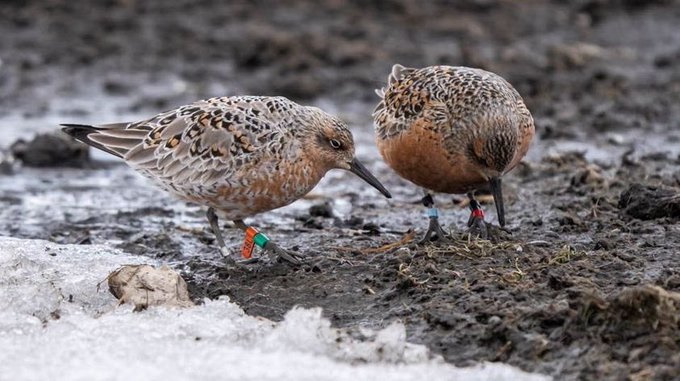
Orange Flag 38L was ringed at Ainsdale
on 04/03/2022.
I quote my friend Richard Du Feu (keen wader ringer and colour ring
spotter) on twitter:
"Over 100 sightings have come in this year from outside of the UK of
the Merseyside colour ringed (orange flags) Knot. The most remarkable
is 38L which has appeared in Arctic Bay, Baffin Island, 4,100km away.
This is very much in the area of uncertainty between Rufa and Islandica
races."
Clare Kines (who describes himself as a retired
Mountie, denizen of the Arctic and a keen birder) put the above photo
on Twitter and I quote:
"My friend, Jack Willie, took this shot of two ringed Red Knots
(islandica ssp) that he found.
On the left 38L, was ringed in
Merseyside UK, the bird on the right we donít have details yet, other
than it was ringed in the Netherlands."
This is the first record in Canada of an Orange
Flagged Knot. When breeding the
knots are scattered across the vast areas of remote tundra in northern
Canada so sightings of colour ringed birds there are indeed rare.
Arctic Bay is a town on the east end of Baffin Island.
Shelduck

Lime ZJ
Ringed at Martin Mere WWT on 19/11/2018.
Recorded:
At Martin Mere in February 2019, and November and December 2019.
It was at Heysham (Morecambe Bay) in September 2020 before returning to
Martin Mere in October 2020 where it seems to have spent that winter.
It was at Woolston Eyes (near Warrington) in March 2021 and February
2022.
Caldy Shore on 13/6/2022.
Given it's appearance on Caldy Shore in mid-June it
seems possible that it has been breeding locally, it's next stop is
likely to be the Mersey Estuary where it will undergo moult along with
thousands of other Shelduck.
Black-headed Gull
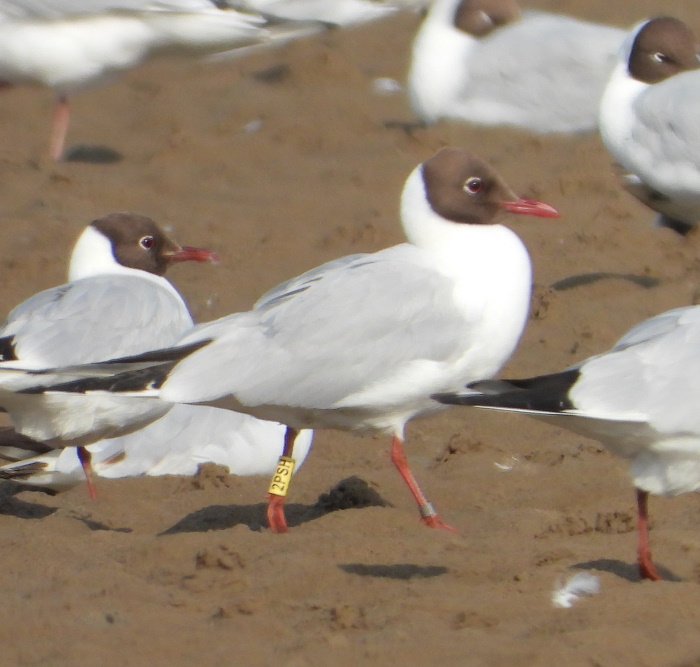
Yellow Ring (2PSH)
Ringed at Pitsea Landfill Site, Essex, on 12/03/2016.
Recorded:
West Kirby shore or Marine Lake in November 2016, October and November
2017, September and November 2018.
There was then a gap in sightings until November 2021.
Last seen on West Kirby shore on 24/06/2022.
The recent record is our only summer sighting of it,
probably indicating it bred locally. All other records have been in the
autumn so we don't know where it spends the winter or where it breeds.
Colour Rings were recorded by Richard Smith and
Steve
Hinde on the Dee Estuary, and Jack Willie in Canada.
Richard Smith
June Bird News
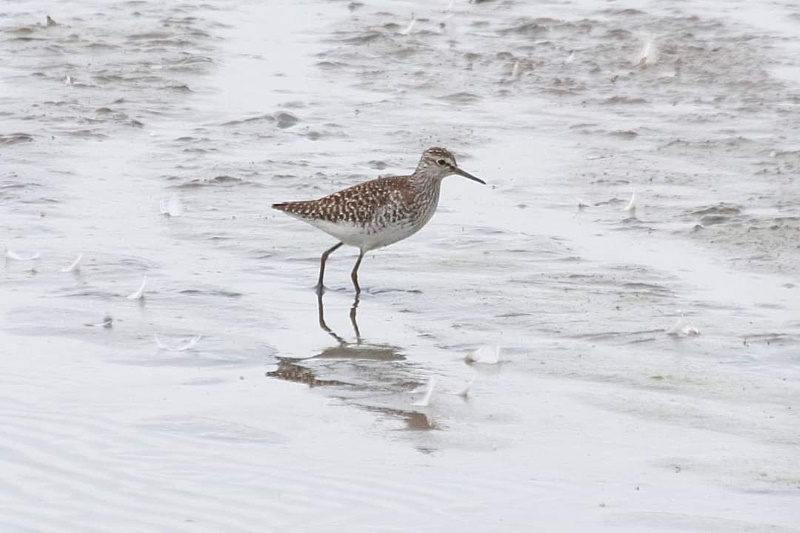

An Osprey over Burton, a Wheatear at Leasowe and small waders on
Gronant beach early in the month indicated that birds were still
migrating north but by mid-month a Little Ringed Plover and six Spotted
Redshanks were back at Burton Mere Wetlands followed by an early Wood
Sandpiper there on the 18th. Waders at Heswall on the 10th, including
five Whimbrel, and at Hoylake on the 13th were probably non-breeders.
One of the Whimbrels was colour ringed and was still at Heswall 10 days
later nicely confirming it's over-summering status (although we were
unable to read the letters on its ring). Also over-summering were
several hundred Black-tailed Godwits at Burton Mere Wetlands, and more
unusually there were five Bar-tailed Godwits with them. Also unusually
an immature Little Gull spent the month around Heswall Shore being seen
regularly over high tide.

A bird well to the west of where it normally would
be expected was a White-winged Black Tern at Burton Mere Wetlands on
the 6th. The first returning Sandwich Terns turned up at Hoylake and
West Kirby on the 14th and the first Mediterranean Gulls away from
their breeding colonies were four at Heswall on the 17th, and they had
increased to eight by the 27th.
Around 70 pairs of Avocets bred at Burton Mere
Wetlands. A pair of Marsh Harriers also bred there for the third year
running and a young bird was seen, we also suspect the Bitterns bred
again but no sign of any young yet as I write this but they are very
difficult to spot in the reeds. There is yet another record season for
the Little Terns with 200 nests counted at Gronant, lets hope that
translates to a record number of fledglings. The smaller Little Tern
colony at Point of Ayr is also doing well with 32 pairs, another record
high.
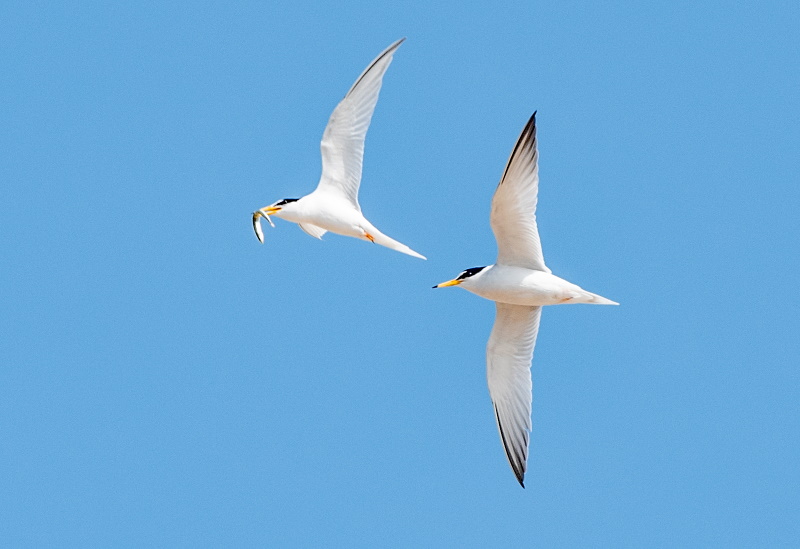
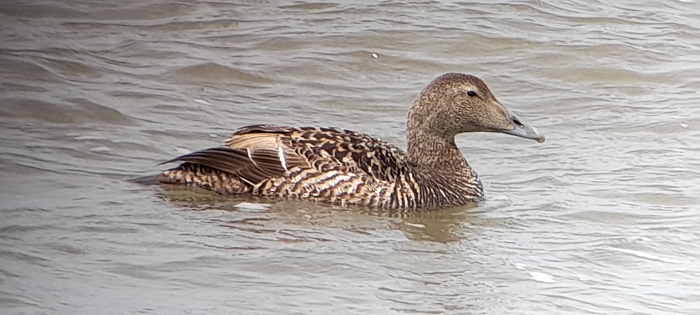
A first for the reserve
What to expect in July
I associate three species in particular with July -
Sandwich Terns, Black-tailed Godwits and Mediterranean Gulls. Sandwich
Terns will be filling up the mouth of the estuary with their raucous
cries and will be bringing their newly fledged young with them. Best
places to see these are at Gronant, Point of Ayr, Hilbre, West Kirby
and Hoylake. Thanks to colour ringing we know these will have bred all
around the Irish Sea - Cemlyn Bay on Anglesey, several colonies along
the east coast of Ireland and Cumbria - and also at sites in
Northumberland. The Dee Estuary and adjacent Sefton Coast are a vitally
important stopover points for them before they make their way south
with
many flying as far as the tip of South Africa (see Sandwich
Tern Article).
I feel privileged to live a short walk from one of the most important Black-tailed Godwit post-breeding moulting sites in the country. This is at Caldy Wildfowl Collection (next to the busy A540) and the first ones will begin arriving either in the last few days of June or the first week in July. They always look glorious at this time of year in full summer plumage and numbers will rapidly rise until well over 2,000 will be there by the month-end when we may get the first juveniles arriving. By the end of August or into September there could be 6,000 here!
Mediterranean Gulls will also be in full summer
plumage early in the month, looking like a Black-headed Gull on
steroids! There will probably be at least ten or so in the estuary and
I always enjoy scanning through the gull flocks at West Kirby and
Thurstaston knowing there's a good chance of seeing a few. Again,
colour ringing tells us where these breed and some come all the way
from the continent including as far east as Poland.
July is often a very good month for rarities and
over the past three or four years these have included Hoopoe, Melodious
Warbler, Long-billed Dowitcher, Roseate Terns, Gull-billed Tern and
Terek Sandpiper.
Forthcoming Events
July Highest Spring Tides (Liverpool)
Also see Tides page.
14th July, 12.18hrs (BST), 9.3m.
15th July, 13.09hrs (BST), 9.4m.
16th July, 13.59hrs (BST), 9.3m.
Forthcoming Events
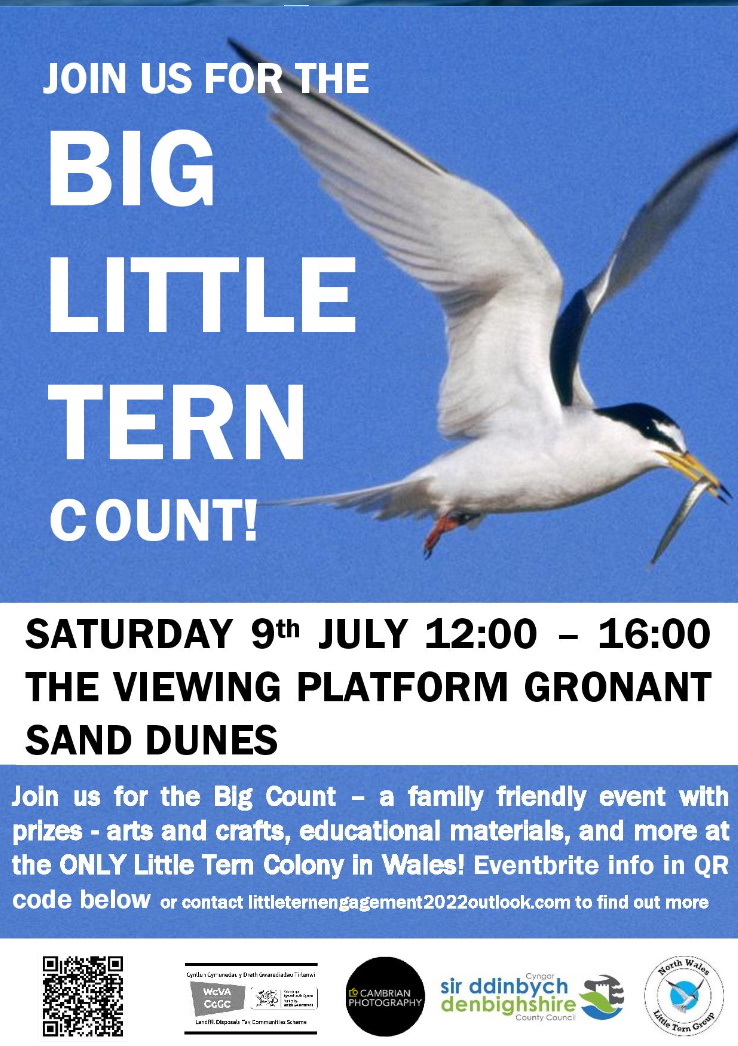
Free and open to anyone. There is free parking at
the car park on Gronant Road, opposite Crofters Cafe. Walk over the
railway bridge and at the end of Gronant Road turn left through the
gate then right over the bridge takeing you across the river, then
follow the boardwalk to the Little Tern Colony.
More details at https://www.eventbrite.com/e/the-big-little-tern-count-tickets-341938496247,
note that pre-booking is not required.